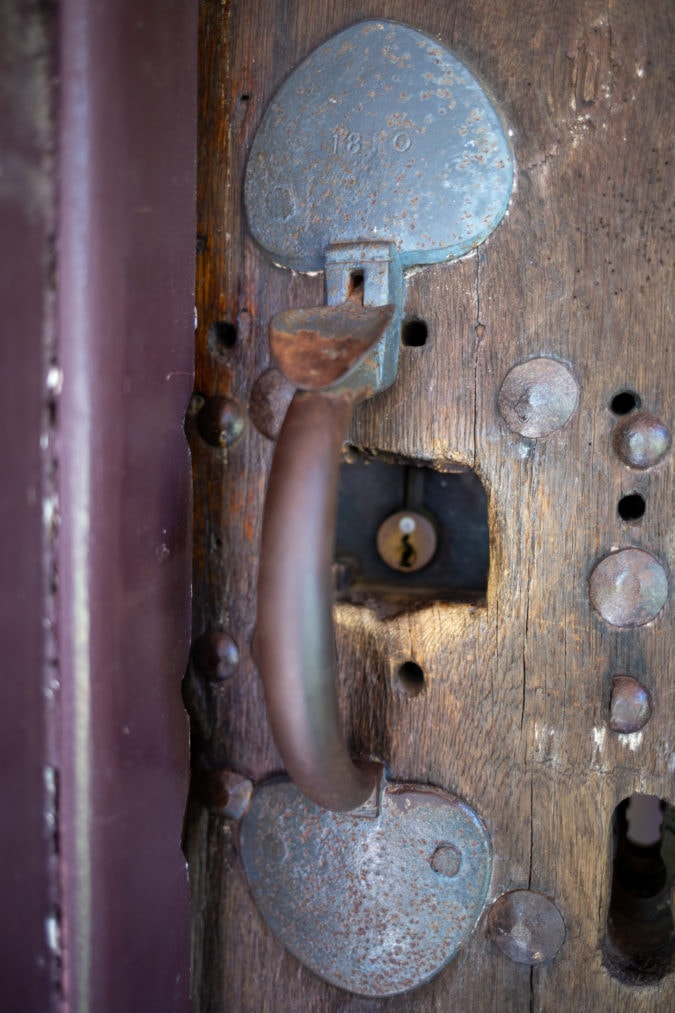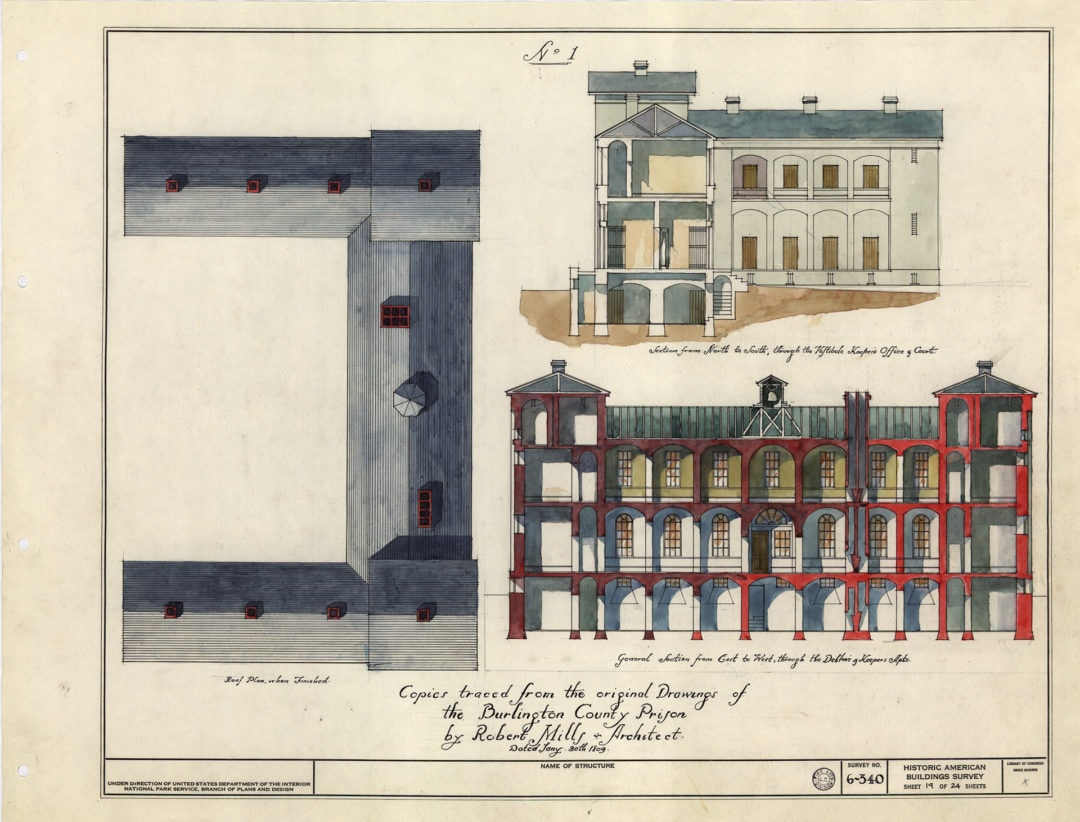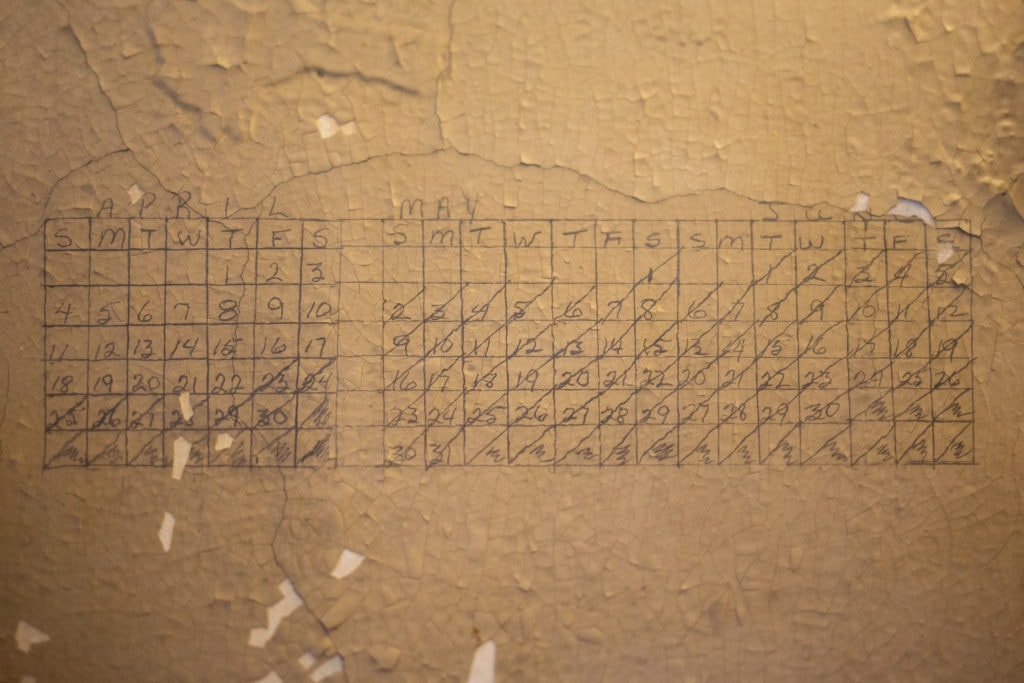In 1876, five men punched a hole through the ceiling of their prison cell, located on the top floor of Burlington County Prison. Four of the men slipped through the hole onto the roof, climbed down a woodpile, and over the prison yard wall to freedom. The fifth man, upset that he was too large to fit through the small opening, didn’t wait long before he snitched on his cellmates. The warden responded immediately to the alarm, but only two of the four escapees were ever caught and returned to the prison.
The Burlington County Prison, located in Mount Holly, New Jersey, was designed not only to minimize escapes, but also to serve as a space to reform inmates “through religious instruction, education, and vocational training.” Operating from 1811 until 1965, the Burlington County Prison was the oldest continuously-used prison in the U.S. at the time it closed.
The Burlington County Prison operated from 1811 until 1965. | Photo: Alexandra Charitan Built in 1887, the warden’s house is now an art gallery. | Photo: Alexandra Charitan
The nonprofit Prison Museum Association (PMA) reopened the prison as a museum in 1966. Mount Holly isn’t the only town with an old prison turned tourist attraction—just 25 miles east is Philadelphia’s Eastern State Penitentiary, which today operates as a historic site and occasional haunted house.
Prisons have always been complicated structures, both physically and emotionally. Monuments to human confinement and suffering, they are both snapshots of another time and important tools in the ever-evolving conversation about mass incarceration in this country and around the world. To begin to understand the present, sometimes it’s best to start in the past.
America’s first architect
I visit the Burlington County Prison Museum on a weekday morning in late July. An East Coast heatwave has just ended and the slightly-cooler temperature in Mount Holly feels revelatory. Visitors to the museum enter through the prison’s heavy oak front door, still outfitted with its original iron hinges, lock, and door handle inscribed with the year “1810.”


The imposing structure was designed by Robert Mills, considered to be the first native-born American trained as an architect. Mills may be most famous for his government buildings and monuments, including the Treasury Building (featured on the back of the 10-dollar bill) and the Washington Monument, but he also designed several courthouses, churches, and prisons.
The Burlington County Prison, built with 18-inch-thick walls made of stone and brick, was designed to hold 40 inmates. When it opened, the penitentiary didn’t have electricity or running water; it was the first prison in the U.S. constructed to be fireproof, and each cell was heated by a wood-burning fireplace.
The cook’s cell in the basement. | Photo: Alexandra Charitan The prisoners ate three meals a day in the basement mess hall. | Photo: Alexandra Charitan The prison didn’t have running water until the 1940s. | Photo: Alexandra Charitan Every cell had a wood-buring fireplace. | Photo: Alexandra Charitan Each door had a small window through which the prisoner would be passed wood for the fireplace. | Photo: Alexandra Charitan The corridors were built with vaulted ceilings to help with air circulation. | Photo: Alexandra Charitan Desk in the warden’s office. | Photo: Alexandra Charitan An aluminum cup found in the exercise yard during recent excavations. | Photo: Alexandra Charitan
Constructed long before air conditioning, the U-shaped corridors have vaulted ceilings to help with air circulation. Despite the cooler temperatures outside, it’s very warm and airless inside of the prison when I visit. Fans have been placed around to help keep air moving, but sometimes lack of comfort is an important step in understanding places with complicated and painful histories.
Designs for a Prison
Mills was concerned not only with keeping prisoners apart from the outside world, but with segregating the inmates themselves. Town dungeons had thrown everyone together in the same space, but mixing pick-pockets in with murderers created conflict. Mills firmly believed in creating a physical distinction between levels of criminality and worked this into his design of the building.
“Where so much Carelessness and malicious Wickedness exist, as are to be found in a prison, and where the safe keeping of the prisoners is of so great importance, every practicable method should certainly be adopted to prevent the bad effects of the former and to insure the reality of the latter,” Mills writes in his 1808 essay, Designs for a Prison.

The first floor, for perpetrators of less severe crimes, had larger windows than the second, which held more serious offenders. A maximum-security cell (known as “the dungeon”) located on the top floor is flanked by niches for additional guards and has a steel ring on the floor to which a prisoner could be chained.
Mills noted that these solitary cells were often placed in basements, which had the unintended consequences of making it easier for the prisoner to escape by digging a tunnel or go mad in the darkness. “The most conspicuous and elevated situation should therefore be chosen for these solitary cells, and very justly, as here there is no possibility of laboring much in secret, or without continual dread of discovery as they are surrounded with Eyes and so easy of access that the keeper (except willfully) cannot neglect to visit them daily,” he writes.
Paranormal activity
Since the prison opened, inmates, guards, and visitors have seen and felt signs of paranormal activity, and the prison is now considered to be one of the most haunted buildings in New Jersey. People have heard moaning and rattling chains; they’ve smelled cigarette smoke and seen apparitions. During renovations in the 1990s, several workmen reported missing tools.

If the Burlington Country Prison is indeed a hotbed of paranormal activity, the dungeon is the epicenter. The cell is supposedly haunted by one of its most notorious inhabitants, Joel Cough, a convicted murderer who spent his last night here in solitary confinement before he was executed and buried in the prison yard. As I stand outside of the cell, Carl Taraschi, a retired lawyer and PMA tour guide, says it’s not uncommon for visitors to feel cold spots or have conversations with the spirits.
The penitentiary welcomes paranormal research groups from all over the country to investigate these claims year-round on Friday and Saturday nights from 7 p.m. to midnight. According to the prison’s website, “Thus far, each group has found evidence of the prison being haunted. They have recorded voices, caught orbs (energy) on film and detected spikes in the electromagnetic field. All of these things combined give the prison museum the title ‘Haunted.’”
A sculpture of a prisoner in the maximum security “dungeon.” | Photo: Alexandra Charitan Photo: Alexandra Charitan Photo: Alexandra Charitan
Visitors need not be in touch with the spirit world to feel something while touring the prison. Whitewashed sculptures of inmates placed in several cells prompt guests to consider the human—and not just architectural—history contained within the prison’s thick walls.
One man sits with his back against the wall of his cell, staring into warm glow of his fireplace. Another sits on the top of a bunk bed, one leg crossed over another, studying cards from a cigar box. In the dungeon, a man is chained to the floor, his body folded in on itself—a visceral, visual reminder of inmates suffering in cells originally designed for one, but that sometimes held two or three inmates due to overcrowding.
Passing time
New prisoners were deloused and given clothes, a straw mattress, bed linens, and a wooden bucket to use for their “night waste,” which they emptied periodically into a cesspool behind the prison. In keeping with Mills’ belief in the power of religion to reform, each inmate was given an inexplicably tiny Bible.


Not all of the prisoners were men. A women’s wing, accessible only by way of a corridor or through the warden’s office, held up to eight women at a time. Women were often imprisoned for adultery or “disorderly conduct” (a euphemism for prostitution) and at least two women gave birth while they were incarcerated. Census figures from the late 1800s note that in addition to adults, the three women’s cells once held a 1-month-old, a 7-month-old, and a 2-year-old.
Despite near-constant supervision, some prisoners passed the time by drawing on the walls of their cells. Although the prison has undergone extensive renovations to remove lead paint, some of this graffiti has been preserved under plexiglass panels. Inmates marked their days away on calendars, inscribed their names for posterity, and sketched powerful religious imagery.
Inmates crossed off the days on the wall of their cells. | Photo: Alexandra Charitan Photo: Alexandra Charitan Photo: Alexandra Charitan
An intricate model of the SS Saint Paul is currently on display alongside a piece of the Berlin Wall, bullets removed from a cadaver, and glass bottles unearthed from the exercise yard during a recent excavation. The model was created by an inmate, who had been a workman on the actual ship, in the late 1890s. When the model resurfaced at an auction in 2010, the PMA purchased it and returned it to the prison. “Some people have tremendous talent, but they just might not use it in the right way,” Taraschi says.
Inmates were given the opportunity to work off their debts in the prison’s workroom. They made brooms, shingles, and baskets up until the 1970s when New Jersey phased out prison work programs (prisoners continued to make license plates until recently).
Others found more violent activities to interrupt their boredom. In 1920, two prisoners—who had just begun 90-day sentences for drunk and disorderly conduct—beat two correctional officers to death with a slotted steel bar from a coal furnace. Both men were judged to be insane and transferred to a nearby asylum.

In the almost hundred years before New Jersey executions were moved to the state’s capital, Trenton, in 1905, seven people were hanged from the gallows in the Burlington County Prison yard (two more people sentenced to death were held in the prison but executed elsewhere). The last hanging took place in 1906—on March 24, convicted murderers George Smalls and Rufus Johnson were executed just two months after committing their crime. On display at the prison today is a piece of the hangman’s rope alongside Johnson’s Bible, and sketches of both men drawn by the son of a guardsmen.
A complicated task
The gallows that now stands in the back prison yard is a replica, modeled after the one that stood in the same spot in 1890. The drop floor was boarded over for safety concerns, but it’s still a macabre reminder of a time when tickets were given out and spectators entered the yard through a side door, eager to witness the latest execution.

It may not have made much difference to the people confined within, but Mills added several decorative elements to the front facade including stone arches; the front door is topped by an engraved sign that reads “prison,” and flanked by relief carvings of keys encircled by chains. The massive door is made from two layers of oak (one set vertically, the other horizontally for strength), joined together by large rivets set in a diamond pattern.

Mills understood that his first project as an independent architect was a complicated one. “The miseries of a prison are Great enough without adding to them,” he writes.
When the Burlington County Prison closed in 1965, more than 100 inmates were moved temporarily to an armory while a new penitentiary was constructed. Continued overcrowding led to the construction of another new prison in 1983, which is still in use.
Taraschi shows me a photo of the current prison, comparing it to Mills’ creation still standing stoically in front of us, 208 years after its construction. “Both buildings are secure,” he says. “Both accomplish what they’re designed to do. But Robert Mills designed beauty into his buildings.”
If you go
The Burlington County Prison Museum is open on Thursdays, Fridays and Saturdays from 10 a.m. to 4 p.m. and on Sundays from noon until 4 p.m. The museum is closed on most holidays and the day after Thanksgiving.






















